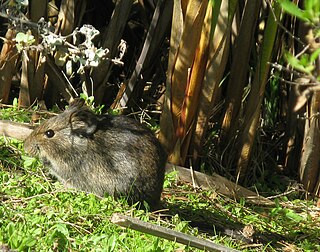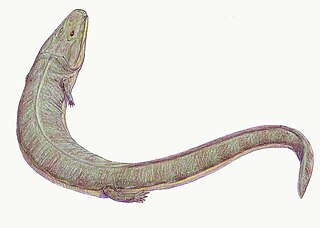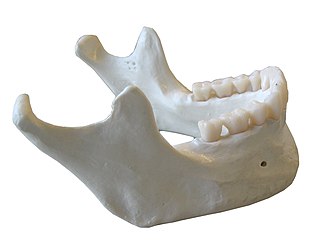Embryonic development also embryogenesis is the process by which the embryo forms and develops. In mammals, the term refers chiefly to early stages of prenatal development, whereas the terms fetus and fetal development describe later stages.

Bisonalveus is an extinct genus of shrew-like mammals that were presumably ground-dwelling and fed on plants and insects. Bisonalveus fossils have been discovered in the upper Great Plains region of North America, including sites in modern-day Wyoming, North Dakota, Montana, and Alberta. The fossils have been dated to 60 million years ago, during the Tiffanian North American Stage of the Palaeocene epoch. Bisonalveus is the last known genus of the Pentacodontinae sub-family to have arisen, replacing the genus Coriphagus in the early Tiffanian. Bisonalveus itself appears to have gone extinct by the middle Tiffanian.

Symmetrodonta is a group of Mesozoic mammals and mammal-like synapsids characterized by the triangular aspect of the molars when viewed from above and the absence of a well-developed talonid. The traditional group of 'symmetrodonts' ranges in age from the latest Triassic to the Late Cretaceous. Most research during the 21st century has concluded that they do not represent a discrete phylogenetic category. However, the name is still used informally by some researchers for convenience, or restricted to the spalacotheriids and zhangheotheriids.

In humans, the cartilaginous bar of the mandibular arch is formed by what are known as Meckel’s cartilages also known as Meckelian cartilages; above this the incus and malleus are developed. Meckel's cartilage arises from the first pharyngeal arch.

In neuroanatomy, a sulcus is a depression or groove in the cerebral cortex. It surrounds a gyrus, creating the characteristic folded appearance of the brain in humans and other mammals. The larger sulci are usually called fissures.
Tritylodontidae is an extinct family of small to medium-sized, highly specialized mammal-like cynodonts, bearing several mammalian traits like erect limbs, endothermy and details of the skeleton. They were the last-known family of the non-mammalian synapsids, persisting into the Early Cretaceous.

African vlei rats (Otomys), also known as groove-toothed rats, live in many areas of sub-Saharan Africa. Most species live in marshlands, grasslands, and similar habitats and feed on the vegetation of such areas, occasionally supplementing it with roots and seeds. The name "vlei" refers to the South African term for intermittent, seasonal, or perennial bodies of standing water.
Microhydromys is a genus of rodent in the family Muridae. It contains the following species:
Pelomys is a genus of rodent in the family Muridae endemic to Africa. It contains the following species:

Styloichthys is a prehistoric sarcopterygian, lobe-finned fish which lived during the Early Devonian (Lochkovian) period of East Yunnan, South China.

The Colosteidae are a family of stegocephalians that lived in the Carboniferous period. They possessed a variety of characteristics from different tetrapod or stem-tetrapod groups, which made them historically difficult to classify. They are now considered to be part of a lineage intermediate between the earliest Devonian terrestrial vertebrates, and the different groups ancestral to all modern tetrapods, such as temnospondyls and reptiliomorphs.

Dryolestoidea is an extinct clade of Mesozoic mammals that only contains two orders. It has been suggested that this group is closely related to modern therian mammals.

Asioryctitheria is an extinct order of early eutherians.

Prozostrodontia is a clade of cynodonts including mammals and their closest non-mammaliform relatives such as Tritheledontidae and Tritylodontidae. It was erected as a node-based taxon by Liu and Olsen (2010) and defined as the least inclusive clade containing Prozostrodon brasiliensis, Tritylodon langaevus, Pachygenelus monus, and Mus musculus. Prozostrodontia is diagnosed by several characters, including:
Makaracetus is an extinct protocetid early whale the remains of which were found in 2004 in Lutetian layers of the Domanda Formation in the Sulaiman Range of Balochistan, Pakistan.
Pyrenasaurus is an extinct genus of lizard that includes only one species, the type species Pyrenasaurus evansae, which lived around the Pyrenees mountains during the Late Eocene. P. evansae was named in 2014 on the basis of three dentaries, one from the Phosphorites du Quercy in Quercy, France and two from the Sossís fossil locality in Catalonia, Spain. The paucity of known material makes its relationships uncertain; it is either a true skink in the family Scincidae or a close relative of skinks in the larger group Scincoidea. Pyrenasaurus is very small for a lizard, with a dentary length of only 3.4 millimetres (0.13 in). It also has very few teeth for a lizard, with only eleven tooth positions in the dentary. Other unusual anatomical features include the shortness straightness of the jaw, the lack of a Meckelian groove on the inside of the dentary, and the enlargement and lateral compression of the posterior-most dentary teeth. Pyrenasaurus may have been a fossorial or burrowing lizard because a short, straight dentary with few teeth is also present in numerous living fossorial lizards, having evolved independently in many lineages. However, the extremely small size of Pyrenasaurus may have inhibited its ability to burrow. The enlarged posterior teeth of Pyrenasaurus suggest it had a specialized diet, but what it was eating remains unknown because no living lizards have similar dentitions.

Spalacotheriidae is a family of extinct mammals belonging to the group Symmetrodonta. They were a rather successful lineage, lasting from the Early Cretaceous to Campanian in North America, Europe, Asia and North Africa. The lack of a Meckelian groove indicate that they had a modern ear anatomy, and their deciduous canines and premolars as well as long lower jaw indicate a carnivorous/insectivorous diet.

Meridiolestida is a clade of non-therian mammals from South America and Africa, and potentially also Australia. It is generally classified within Dryolestida, barring one study recovering them as the sister taxa to spalacotheriid symmetrodonts. However, more recent studies have stuck to the dryolestoid interpretation. They differ from northern dryolestoids in the absence of a parastylar hook on the molariform teeth and the lack of a Meckelian groove.
Soumyasaurus is a small silesaurid dinosauriform from the Late Triassic (Norian) Cooper Canyon Formation of western Texas.











